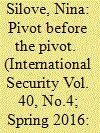| Srl | Item |
| 1 |
ID:
170457


|
|
|
|
|
| Summary/Abstract |
The relationship between the Russian Federation and the People’s Republic of China is one of great complexity and importance to policymakers tasked with forming U.S. foreign policy. Considering the long-term implications for U.S. strategy, the research seeks to anticipate future trends in the Sino/Russia relationship using scenario planning techniques to develop four distinct yet impactful scenarios for policymakers to consider. From a list of highlighted “driving forces” in the Sino/Russia relationship, the research points to two critical uncertainties (U.S. policy and Central Asia) that could dictate the future relationship between the two powers. The scenarios include hypothetical events in a multitude of areas, which could have significant consequences for the two countries. The study recommends a change in U.S. policy that accounts for the growing environmental and technological tensions that are driving current geopolitical unrest in the developing world and suggests that a change is taking place in how the global community defines, conceptually, the role of great-power politics
|
|
|
|
|
|
|
|
|
|
|
|
|
|
|
|
| 2 |
ID:
181590


|
|
|
|
|
| Summary/Abstract |
The United States has a deep interest in stopping Israel from falling any further into China’s orbit. Doing so requires mobilizing non-military tools of diplomacy, including some coercive ones, to bring Israel around to the U.S. position.
|
|
|
|
|
|
|
|
|
|
|
|
|
|
|
|
| 3 |
ID:
145229


|
|
|
|
|
| Summary/Abstract |
American critics of the Barack Obama administration's 2011 “pivot to Asia” policy claim that, despite the lofty rhetoric, the United States has pursued an anemic strategy in Asia. Chinese critics of the pivot to Asia assert that it is a bellicose strategy aimed at containing China's rise. These two conflicting criticisms are addressed in a detailed historical narrative that traces the development and implementation of U.S. strategy, based on declassified documents, some of which have never before been made public, and extensive in-depth interviews with senior policymakers. Neither American nor Chinese critics of the pivot to Asia are correct. If this policy is properly dated and measured, the United States undertook a substantive military, diplomatic, and later economic reorientation toward Asia. That reorientation started in the mid-2000s, well before the pivot announcement. The aim of the reorientation was not to contain China's rise. Rather, the United States sought to manage China's growth through a blend of internal and external balancing combined with expanded engagement with China. These means were intended to work symbiotically to expand the combined power of the United States and its allies and partners in Asia, and to dissuade China from bidding for hegemony. The ultimate effect of the reorientation strategy—if successful—would be to preserve the existing power balance in the region, in which the United States has held the superior position.
|
|
|
|
|
|
|
|
|
|
|
|
|
|
|
|
| 4 |
ID:
181576


|
|
|
|
|
| Summary/Abstract |
Thinking about civilization and not just about modernity and the state is a way for the United States to do better in this crucial and complex region.
|
|
|
|
|
|
|
|
|
|
|
|
|
|
|
|
| 5 |
ID:
166240


|
|
|
| 6 |
ID:
151334


|
|
|
|
|
| Summary/Abstract |
The United States will soon reach a crossroads in its struggle against terrorism. The international coalition fighting the Islamic State (also known as ISIS) has driven the group out of much of the territory it once held and, sooner or later, will militarily defeat it by destroying [1] its core in Iraq and Syria. But military victory over ISIS will not end the global war on terrorism that the United States has waged since 9/11. Some of ISIS’ provinces [2] may outlive its core.
|
|
|
|
|
|
|
|
|
|
|
|
|
|
|
|